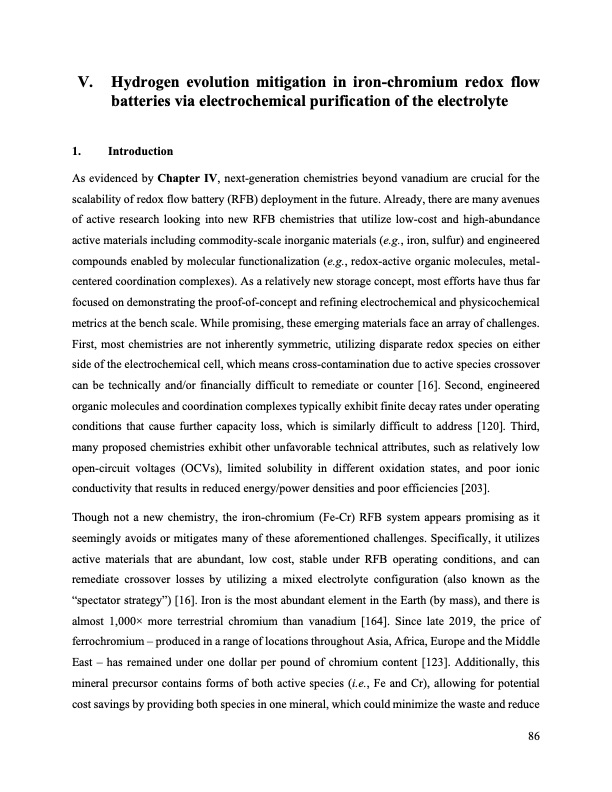
PDF Publication Title:
Text from PDF Page: 086
V. Hydrogen evolution mitigation in iron-chromium redox flow batteries via electrochemical purification of the electrolyte 1. Introduction As evidenced by Chapter IV, next-generation chemistries beyond vanadium are crucial for the scalability of redox flow battery (RFB) deployment in the future. Already, there are many avenues of active research looking into new RFB chemistries that utilize low-cost and high-abundance active materials including commodity-scale inorganic materials (e.g., iron, sulfur) and engineered compounds enabled by molecular functionalization (e.g., redox-active organic molecules, metal- centered coordination complexes). As a relatively new storage concept, most efforts have thus far focused on demonstrating the proof-of-concept and refining electrochemical and physicochemical metrics at the bench scale. While promising, these emerging materials face an array of challenges. First, most chemistries are not inherently symmetric, utilizing disparate redox species on either side of the electrochemical cell, which means cross-contamination due to active species crossover can be technically and/or financially difficult to remediate or counter [16]. Second, engineered organic molecules and coordination complexes typically exhibit finite decay rates under operating conditions that cause further capacity loss, which is similarly difficult to address [120]. Third, many proposed chemistries exhibit other unfavorable technical attributes, such as relatively low open-circuit voltages (OCVs), limited solubility in different oxidation states, and poor ionic conductivity that results in reduced energy/power densities and poor efficiencies [203]. Though not a new chemistry, the iron-chromium (Fe-Cr) RFB system appears promising as it seemingly avoids or mitigates many of these aforementioned challenges. Specifically, it utilizes active materials that are abundant, low cost, stable under RFB operating conditions, and can remediate crossover losses by utilizing a mixed electrolyte configuration (also known as the “spectator strategy”) [16]. Iron is the most abundant element in the Earth (by mass), and there is almost 1,000× more terrestrial chromium than vanadium [164]. Since late 2019, the price of ferrochromium – produced in a range of locations throughout Asia, Africa, Europe and the Middle East – has remained under one dollar per pound of chromium content [123]. Additionally, this mineral precursor contains forms of both active species (i.e., Fe and Cr), allowing for potential cost savings by providing both species in one mineral, which could minimize the waste and reduce 86PDF Image | Bringing Redox Flow Batteries to the Grid

PDF Search Title:
Bringing Redox Flow Batteries to the GridOriginal File Name Searched:
Rodby-krodby-phd-chemE-2022-thesis.pdfDIY PDF Search: Google It | Yahoo | Bing
Salgenx Redox Flow Battery Technology: Salt water flow battery technology with low cost and great energy density that can be used for power storage and thermal storage. Let us de-risk your production using our license. Our aqueous flow battery is less cost than Tesla Megapack and available faster. Redox flow battery. No membrane needed like with Vanadium, or Bromine. Salgenx flow battery
| CONTACT TEL: 608-238-6001 Email: greg@salgenx.com | RSS | AMP |